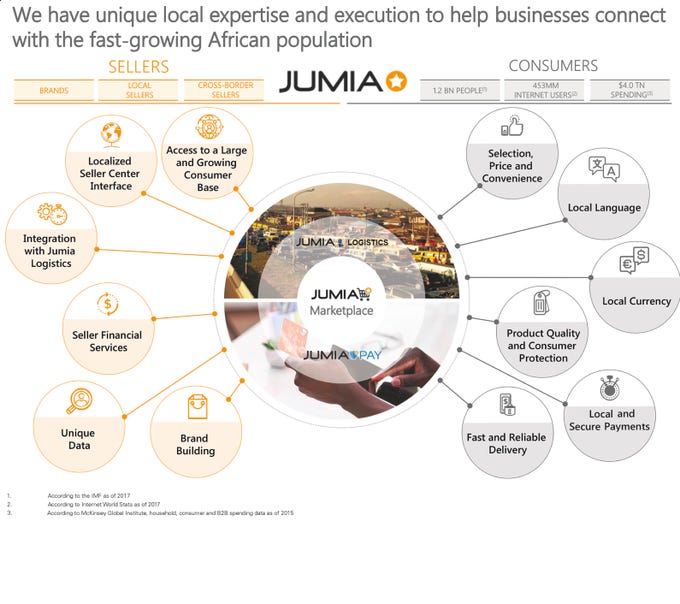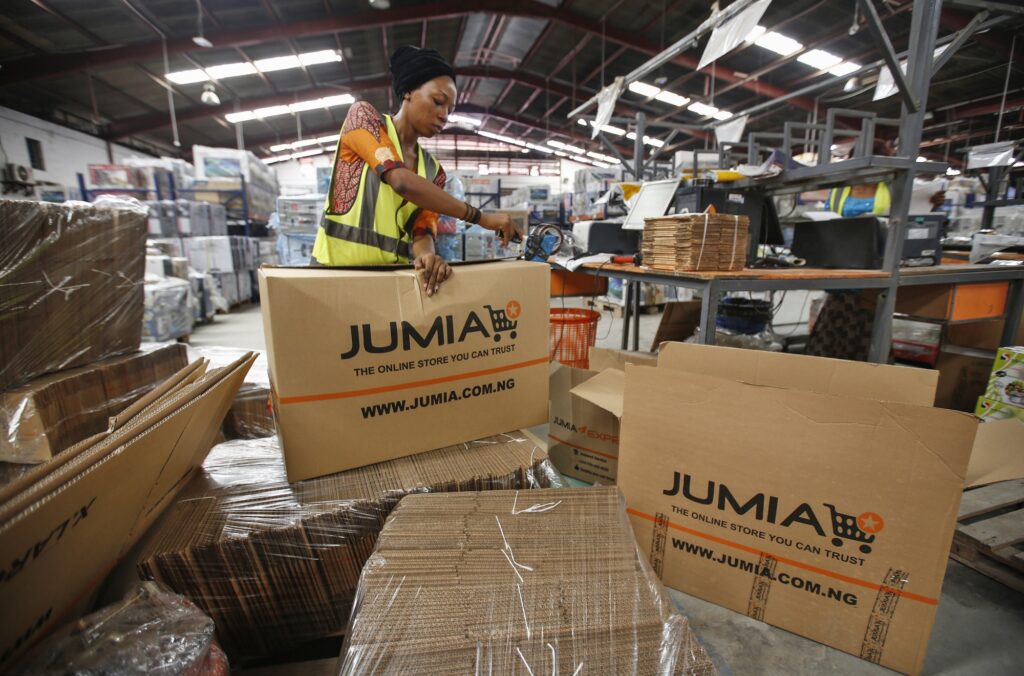Jumia – Ecommerce in Africa

Jumia’s attempt to become the Amazon of Africa
With the world’s largest population growth of any continent, increased access to the internet, increased urbanization, and increase in per capita income, African consumers’ demand for products is rapidly increasing. These population, technological, and economic pressures are stressing the traditional retail markets of the African continent. Jumia, founded in 2012, seeks to add value to the growing consumer base of the African continent by leveraging technology and logistics to provide an ecommerce solution to rapidly growing consumer demand.
Value Creation
Jumia’s value proposition can be categorized along the dimensions of wide product selection, convenience, fast, trusted, and reliable delivery, secure payments.

Wide Product Selection
Jumia provides unmatched product selection and choice to African consumers through its ecommerce websites (each tailored to the specific country’s market). Products range from phones, the most popular item sold, to clothing and beauty products.
Convenience
Increased smartphones and internet penetration on the African continent are driving rapid ecommerce sales on the continent. By 2025, Africa is projected to surpass half a billion e-commerce users and the ecommerce sales are expected to grow at a compound annual growth rate of 13.11% between 2023 and 2017. As the largest ecommerce platform on the continent, Jumia is pivotal to this growth. Central to its market lead is the end-to-end convenience that it provides its customers from online purchase (with the ability to pay through mobile money for some transactions), to tracking and delivery. With the continent’s increased urbanization resulting in suffocating traffic, convenience is a considerable value proposition for many customers.
Fast, Trusted, and Reliable Delivery
Africa’s infrastructure deficits make it difficult to provide reliable delivery services to consumers. Jumia has not, however, found these challenges insuperable. By developing its logistics capabilities, they’ve been able to find workarounds to many of these infrastructural l challenges. These workarounds include: managing its own internal delivery fleet in areas where it would be most efficient while partnering with local delivery services in regions where it would be prohibitive for them to do so, inhouse warehouses, creating its own pick-up stations, and package tracking.

Secure Payments
Mobile money payments and transfers have become ubiquitous on the African continent since the introduction of M-Pesa in 2007. In 2022, 66.3% of all mobile money transactions occurred in Africa. This ubiquity of mobile money payment and transfer has built a trust in the African population for the payment mechanism. Jumia developed its own mobile money wallet in 2016, called JumiaPay, allowing merchants and customers to seamlessly transact in the platform.
Value Capture
In business, it’s important to capture value where value is created. As discussed above, the key nodes at which Jumia creates value are product postings and selections, electronic payments systems, and delivery. Jumia captures value at all these points. For postings, selection, and delivery Jumia captures value with commission and fulfillment fees (making up 70% of their revenues). While Jumia does not capture direct monetary value from JumiaPay, the convenience that it provides drives indirect value to Jumia in increasing transactions and customers and suppliers on its platform.
Challenges
The primary challenge that Jumia is facing in scaling its business is the lack of robust civil infrastructure in Africa. While, the firm is finding workarounds to these infrastructural challenges, they are nevertheless costly. Economic instability in the continent also dampens scalability. A palpable example is the firm losing 1 million customers in Nigeria from Q2 2022 to Q3 2023 due to the country’s chronic inflation. A lack of locally manufactured goods also increases distribution costs to the end customer.
Sources
Sturgeon Capital. “Jumia: The Challenges and Opportunities Facing the African E-commerce Giant.” Accessed on November 7, 2023. https://sturgeoncapital.com/jumia-the-challenges-and-opportunities-facing-the-african-ecommerce-giant/.
TechCrunch. “Jumia co-CEO Jeremy Hodara Talks African E-commerce and His Company’s Path to Profitability.” Accessed on November 7, 2023. https://techcrunch.com/2021/02/26/jumia-co-ceo-jeremy-hodara-talks-african-e-commerce-and-his-companys-path-to-profitability/.
Nairametrics. “Jumia Loses 1 Million Customers to High Inflation in Nigeria, Others.” Accessed on November 7, 2023. https://nairametrics.com/2023/08/15/jumia-loses-1-million-customers-to-high-inflation-in-nigeria-others/.
Jumia Blog. “Jumia to Launch Mobile Money Wallet – Jumia Pay.” Jumia Blog, https://blog.jumia.com.ng/jumia-launch-mobile-money-wallet-jumia-pay/.
Ecofin Agency. “Africa Accounted for Over Two-Thirds of the Global Mobile Money Transactions in 2022: Report.” Accessed on November 7, 2023. https://www.ecofinagency.com/finance/2604-44461-africa-accounted-for-over-two-thirds-of-the-global-mobile-money-transactions-in-2022-report.
Business Wire. “Jumia Opens Logistics Service to Third Parties.” Accessed on November 7, 2023. https://www.businesswire.com/news/home/20201102005539/en/Jumia-Opens-Logistics-Service-to-Third-Parties.
Statista. “E-commerce Worldwide – Revenue Projections.” Accessed on November 7, 2023. https://www.statista.com/outlook/emo/ecommerce/worldwide?currency=usd#revenue.



Thanks Abdoulaye! Can you talk a bit more what it is in particular that allowed Jumia to overcome some of the daunting challenges in Africa that its competitors couldn’t? In particular, my understanding has been that in environments where there are low levels of infrastructure, local players tend to win because of their ability to better understand the terrain and focus on being more precise in managing operations. In these cases, you have a very fragmented vendor ecosystem without any dominant players. Secondly, given these infrastructure woes, I wonder if Jumia has received any government assistance in helping create infrastructure that benefits both the commercial and community interests; for example, I’ve read in other cases where local governments have collaborated with large companies to build roads, dams, and ports, all to support the growth of a particular industry (or company) there.
Awesome post! How have the differences in consumer behavior between Africa and the US been reflected on the platform? India faced a similar situation a couple of years ago – huge growth in mobile penetration and online payments, but a lot of consumer behavior remained the same and it was difficult to analyze data on why. For instance, a company called Meesho, the Amazon for Tier 2 cities, couldn’t identify why their users were purchasing around 70% of the typical household items from them but not the last 30% (vs what you’d see on Amazon). With some research, they realized two things – first, malls were a big part of going out in India and second, the woman who bought these items for her home didn’t want to give up her “Sunday morning mall time” with her family by buying everything she needed online. This cultural difference changed how Meesho surfaced household items vs Amazon. Are you seeing similar cultural differences in Africa and how have they been reflected on the platform?